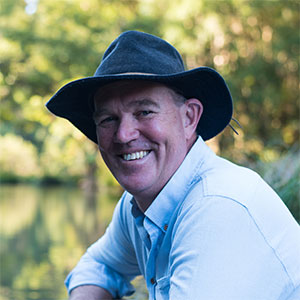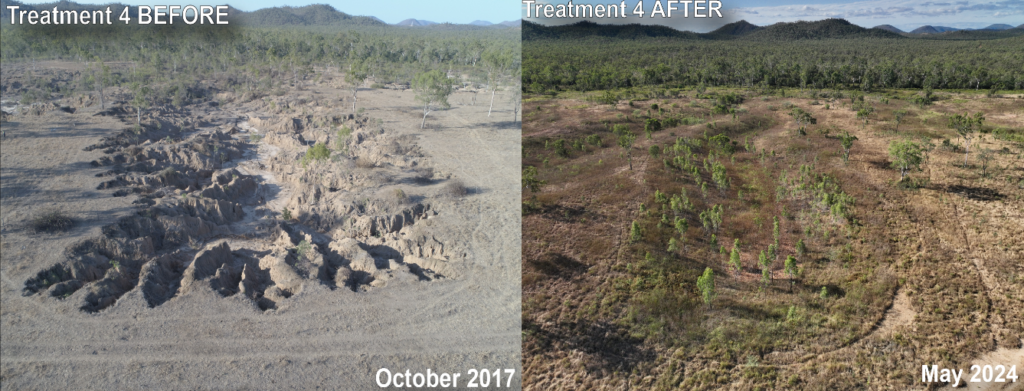A new study conducted at Bonnie Doon Creek on the lower Burdekin River in Queensland has demonstrated a significant reduction in sediment yield through large-scale remediation of alluvial gullies.
The research, led by Associate Professor Andrew Brooks from Griffith University's Coastal and Marine Research Centre, used a Before After Control Impact (BACI) design field experiment, to measure the effectiveness of GBR water quality improvements that can be achieved through targeted gully remediation.
The study focused on four large alluvial gully complexes, covering an active area of approximately 17 hectares.

Prior to remediation, these gullies were estimated to be contributing 5,800 ± 1,500 tonnes of fine sediment (particles smaller than 20 µm) per year, based on a 20-year baseline average.
The remediation efforts resulted in a remarkable reduction of 96%-99% in fine sediment yield within one year, translating to an annual reduction of approximately 5,500 tonnes from just these four gullies.
"Before we started this research, these big alluvial gullies had been put in the too hard basket for being tackled by local Natural Resource Management groups. So a key objective of this study was to demonstrate how these large gullies can be remediated, and what sort of sediment reductions can be achieved through the remediation process," Associate Professor Brooks said.
"Associated research by our group has demonstrated a small number of these large gullies, representing around 2% of the gully population in the Bowen catchment, are contributing 30% of the gully sediment sourced from this catchment.
"Hence, given the significance of these large gullies as sediment sources, it is not an option to leave them untreated if GBR water quality targets are to be achieved."
Researchers employed high-resolution lidar Digital Elevation Models (DEMs) of Difference (DoD) to measure sediment yields in the unremediated gullies. These DEMs were acquired by research partners Airborne Research Australia, using their unique powered glider aircraft, which are ideal for the high resolution (0.1m) lidar acquisition needed for this research.
However, even these lidar-derived yields were found to be on average 58% lower than those derived from monitored suspended sediment concentration (SSC) data.
Another key finding of this research was the identification of the greatest uncertainty in predicting sediment decrease from gully remediation.
The study suggested that even high-resolution lidar might miss erosion processes driven by rainfall across internal gully surfaces that fell below the lidar's limit of detection, particularly in the unremediated gullies.
Baseline sediment yields at the study sites may be as much as 270% higher than initially estimated, when widespread downwearing erosion is taken into account, with the analysis suggesting that original assessments may have been overly conservative.

"If you underestimate the pre-remediation gully sediment yield - you might actually be underestimating the sediment yield reductions that have been achieved," Associate Professor Brooks said.
"However, perhaps more importantly, given that decisions about where resources are directed are based on the 'dollars per tonne' of sediment abatement, some sites will not be remediated if the sediment yield side of this equation is underestimated.
"Current methods employed by those responsible for funding gully remediation, have been underestimating the yields from these large alluvial gullies, and likely overestimating yields from other gullies. The result of this is that some of these high yielding gullies are not given the go ahead for remediation and resources are redirected."
Associate Professor Andrew Brooks
"This research underscores the importance of developing a detailed understanding of baseline sediment yields and the processes driving gully evolution over time.
"Such knowledge is crucial for the economic justification of remediation efforts and for ensuring that the scale of the works matches the scale of the problem."
The findings also highlighted that achieving similar sediment reduction results in smaller-scale gullies would require treating more than 40,000 gullies, emphasising the effectiveness of remediation efforts in these large gullies.
Associate Professor Brooks and the team called for future research to improve the understanding of baseline sediment yields and to enhance the accuracy of sediment abatement predictions in various gully types.
The findings 'The effectiveness of alluvial gully remediation in Great Barrier Reef catchments' has been published in International Soil and Water Conservation Research.











